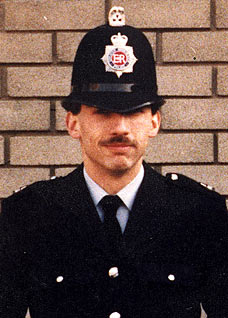
The Royal Ulster Constabulary (RUC) was the police force in Northern Ireland from 1922 to 2001. It was founded on 1 June 1922 as a successor to the Royal Irish Constabulary (RIC) following the partition of Ireland. At its peak the force had around 8,500 officers, with a further 4,500 who were members of the RUC Reserve.
The Ulster Defence Regiment (UDR) was an infantry regiment of the British Army established in 1970, with a comparatively short existence ending in 1992. Raised through public appeal, newspaper and television advertisements, their official role was the "defence of life or property in Northern Ireland against armed attack or sabotage" but unlike troops from Great Britain they were never used for "crowd control or riot duties in cities". At the time the UDR was the largest infantry regiment in the British Army, formed with seven battalions plus another four added within two years.

Cheshire Constabulary is the territorial police force responsible for policing the ceremonial county of Cheshire in North West England, comprising the unitary authorities of Cheshire East, Cheshire West and Chester, Borough of Halton and Borough of Warrington. The force is responsible for policing an area of 946 square miles (2,450 km2) with a population of approximately 1 million people.

Cumbria Constabulary is the territorial police force in England covering the unitary authority areas of Cumberland and Westmorland and Furness in the ceremonial county of Cumbria. As of September 2017, the force had 1,108 police officers, 535 police staff, 93 police community support officers, and 86 special constables.

Derbyshire Constabulary is the territorial police force responsible for policing the county of Derbyshire, England. The force covers an area of over 1,000 square miles (3,000 km2) with a population of just under one million.

The Police Memorial Trust is a charitable organisation founded in 1984 and based in London. The trust's objective is to erect memorials to British police officers killed in the line of duty, at or near the spot where they died, thereby acting as a permanent reminder to the public of the sacrifice they made.

Leicestershire Police is the territorial police force responsible for policing the counties of Leicestershire and Rutland in England. Its headquarters are at Enderby, Leicestershire.

Hertfordshire Constabulary is the territorial police force responsible for policing the county of Hertfordshire in England. Its headquarters is in Welwyn Garden City. The current chief constable is Charlie Hall. As of March 2019, the force consists of over 1,900 police officers, 235 PCSOs, and over 1500 police staff, as well as being supported by more than 410 special constables.

Durham Constabulary is the territorial police force responsible for policing the council areas of County Durham and Darlington in North East England. It does not cover all of the ceremonial or historic area of Durham, parts of which are covered by the neighbouring forces of Cleveland Police and Northumbria Police. The other neighbouring forces are Cumbria Constabulary to the west and North Yorkshire Police to the south.

Staffordshire Police is the territorial police force responsible for policing Staffordshire and Stoke-on-Trent in the West Midlands of England. It is made up of 11 local policing teams, whose boundaries are matched to the nine local authorities within Staffordshire.

North Yorkshire Police is the territorial police force covering the unitary authorities of North Yorkshire and the City of York in northern England. As of April 2024 the force had a strength of 1,665 police officers, 127 special constables, 192 PCSOs and 1,072 police staff. Of the 43 territorial police forces in England and Wales, the force has the 3rd largest geographic area of responsibility whilst being the 15th smallest force in terms of police officer numbers.

PC Gerald Michael "Ged" Walker was an English police dog handler with Nottinghamshire Police who was killed in the line of duty in Bulwell, Nottingham, in 2003.

Séamus Turlough McElwain was a volunteer in the South Fermanagh Brigade of the Provisional Irish Republican Army (IRA) during The Troubles, who was killed by British special forces while preparing to ambush an army patrol.
Major James Matthew Stronge was a soldier and Ulster Unionist Party MP in the Parliament of Northern Ireland, and the later Northern Ireland Assembly. He was the son and heir of Sir Norman Stronge, Bt; they were both killed by the Provisional Irish Republican Army at his family home, Tynan Abbey.

The Canadian Police and Peace Officers' Memorial is a memorial in Ottawa, Ontario, commemorating approximately 900 Canadian law enforcement officers killed in the course of their duties. Dedicated in 1994, it is located at the northwest corner of the Parliament Hill grounds, overlooking the Ottawa River. The memorial consists of the Police Memorial Pavilion, a reconstruction of a 1877 gazebo by Thomas Seaton Scott, and a glass-and-steel perimeter wall etched with the names of the fallen officers, which was designed by landscape architectural firm Phillips Farevaag Smallenberg.
In the United Kingdom police firearm policy varies by constituent countries. In Northern Ireland, all police officers carry firearms whereas in the rest of the United Kingdom, firearms are carried only by specially-trained firearms officers.

DC Stephen Robin Oake, was a police officer serving as an anti-terrorism detective with Greater Manchester Police in the United Kingdom who was murdered while attempting to arrest a suspected terrorist in Manchester on 14 January 2003.

The Police Roll of Honour Trust is a charitable organisation registered in England & Wales and Scotland, it was founded in 2000 and records all those British police officers who have died on and in the line of duty. It has been granted a Royal Charter.






















